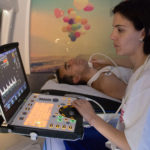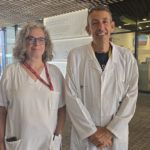
The Vall d’Hebron University Hospital has developed, in collaboration with the Hospital de Sant Pau and the Hospital del Mar, a predictive model, published in The Lancet, which helps oncologists identify which patients with metastatic cancer and systemic treatment who are admitted to emergency care, primarily for pain, fever, or difficulty breathing, are at greater risk of dying in the next 90 days.
This tool, called “PROMISE Score” stands for “Prognostic Score for Hospitalized Cancer Patients” It is a simple web application for healthcare professionals to use. Based on clinical and laboratory information readily available at the time of admission, it accurately predicts the 90-day mortality risk in patients with advanced cancer receiving active treatment. The main goal of this application is to assist the medical team in identifying patients who are more likely to survive without the need for further testing and to help them make decisions.
Identifying risk parameters at the time of admission helps the medical team guide their care, improve the quality of assistance, and avoid unnecessary procedures in situations where there will be no clear benefit from treatment, beyond cost reduction. “The model we have developed has strong predictive power for patients with a favorable prognosis, with whom we can more confidently opt for aggressive therapeutic interventions,” explains Dr. Oriol Mirallas, an attending physician in the Medical Oncology Department at Vall d’Hebron Hospital and a researcher at the Molecular Therapy Research Unit UITM-CaixaResearch at the Vall d’Hebron Institute of Oncology (VHIO). Dr. Oriol Mirallas is the lead author of this study, which involved the collaboration of 41 professionals, along with Dr. Joan Carles, head of the hospital’s section and head of the Genitourinary, Central Nervous System, Sarcoma, and Unknown Primary Tumor Unit, as well as the Genitourinary, Central Nervous System, and Sarcoma Tumor Group at VHIO, and Dr. Rodrigo Dienstmann, head of the Oncology Data Science (ODysSey) Group at VHIO, who helped develop the model and the web tool.
Thanks to this new tool, patients at high risk of mortality can be spared invasive treatments that will not improve their prognosis, reducing unnecessary suffering. “It is proven that nutritional support and community-based palliative care improve the quality of life and survival of patients in this advanced stage of the disease” emphasizes Dr. Joan Carles.
First Tool Filling a Gap in Clinical Practice
Survival estimates are a key element when making decisions about cancer patient care. “Until now, professionals used clinical data validated in outpatient patients, such as tumor stage, treatment response, or the patient’s functional level according to the ECOG scale (designed by the Eastern Cooperative Oncology Group and validated by the World Health Organization), which assesses the quality of life of cancer patients, combined with clinical experience to determine the best medical management” explains Dr. Oriol Mirallas. “But with this prognostic model, we have an objective and quantifiable measure that will help us understand the patient’s evolution upon admission. The PROMISE tool will provide more precise data to improve and facilitate decision-making” he adds.
Dr. Berta Martín Cullell, from the Medical Oncology Department at the Hospital de Sant Pau and a researcher in the study, comments that “with the validation of the PROMISE Score tool at our center, we have confirmed that this model allows us to accurately predict the prognosis of oncology patients admitted with acute complications” “This helps us identify which patients may benefit from more aggressive interventions and improves the quality of medical decisions. This tool, based on accessible clinical data, is a valuable resource for optimizing personalized treatment and preserving the quality of life of patients” she specifies.
Dr. Sònia Servitja, head of the Breast Section of the Medical Oncology Department at the Hospital del Mar and a researcher in the study, adds that “it was essential to develop a tool to individualize the therapeutic intensity for admitted patients, beyond parameters like ECOG and treatment response” “Currently, we are able to individualize treatment thanks to molecular studies; we have toxicity prediction scales for cancer treatments, especially in older and/or frail patients, which allow us to decide whom and how to treat, but we lacked more objective data to decide when to stop treatment, avoiding doing more harm than good. Now, with the PROMISE Score, we can identify hospitalized patients with a better prognosis, and it will help us make decisions” she emphasizes.
This new prognostic model fills a gap in the knowledge and clinical practice for hospitalized oncology patients. The available studies to date have focused on geriatric patients or studies conducted in a single center, with few patients primarily treated with chemotherapy, which does not reflect the current therapeutic landscape. “The current availability of personalized oncology treatments, with combinations of immunotherapy and other targeted therapies applied to thousands of patients, has forced us to seek new tools to assess prognosis and impact in this population, in order to optimize and adapt our daily clinical practice” points out Dr. Sònia Serradell, head of the Medical Oncology ward at Vall d’Hebron.
A Personalized Algorithm
To create this application and obtain an objective measure, a sample of 1,009 patients was analyzed: 749 admitted to Vall d’Hebron and 260 from the Hospital de Sant Pau and the Hospital del Mar, who have been the validation group. At the time of admission, the patients were over 18 years old, had a confirmed advanced or metastatic solid tumor (primarily lung, gastrointestinal, or gynecological, the most prevalent), had received anticancer systemic treatment at least six months before hospitalization, and were admitted to emergency care or the ward for a minimum of 24 hours. The patients in the Vall d’Hebron model creation group were admitted between March 2020 and February 2022, and those in the external validation group between January 2021 and February 2022. The average age was 65 years, 51% were women, with an average time since diagnosis of 22 months, and the average hospitalization lasted 9 days.
The web application https://promise.vhio.net/ allows for the calculation of an individualized value to predict 90-day mortality in patients hospitalized for emergency care with advanced cancer and active treatment. It analyzes a series of clinical and laboratory factors readily available at the time of admission. A high level of LDH (tumor burden), neutrophils (inflammation), and albumin (a protein that indicates the nutritional status of the patient) in the blood analysis at emergency admission are associated with a worse prognosis. The ECOG functional status, the latest CT reports estimating treatment response and disease progression, the tumor stage, and the patient’s emotional state are also evaluated. With these values, the PROMISE Score calculates an algorithm that helps identify those patients who would have a survival exceeding 90 days without the need for additional testing. “The survival percentage is an objective measure that helps the medical team make clinical decisions, but the final strategy planning will always be done in consensus with the patients, their families, and the treating physician” specifies Dr. Oriol Mirallas.
Care Adapted to Each Patient
“Unscheduled hospitalizations are common in cancer patients and are usually related to complications arising from cancer, infections, or treatment-related toxicity problems” states Dr. Joan Carles. This tool can help expedite decisions and optimize hospitalizations, as well as reduce prolonged and repeated admissions that can be avoided in terminal patients. Cancer treatment is a delicate balance between prolonging survival and maximizing quality of life. Hospitalization does not always provide benefits and can even be a stressful experience for both patients and caregivers, as well as impose a greater financial burden compared to outpatient care. “We are fully committed to the well-being and care of our patients, and this tool will help us tailor therapeutic efforts to each patient, achieving maximum benefit” emphasizes Dr. Sònia Serradell.
The web application is available for professionals treating oncology patients through the link https://promise.vhio.net/. “We will continue working to refine and validate the PROMISE Score in other populations and contexts to help as many patients and professionals as possible” concludes Dr. Oriol Mirallas. This tool, which will now be implemented in other centers to conduct an international study with more patients, was designed during Dr. Oriol Mirallas‘s second year of residency and also involved the collaboration of physicians from the Medical Oncology Department, the supervisor of the Medical Oncology ward, Ada Alonso, nursing auxiliary care technicians, and the nutrition team.






















